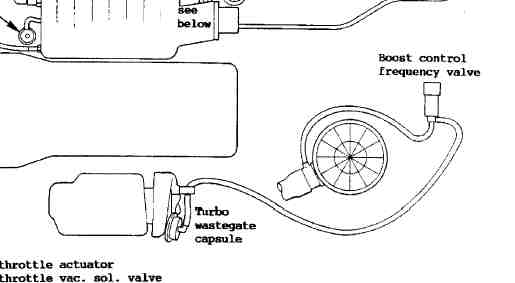Technical Background
Boost control
The underlying passive boost control system
The Elan has a simple underlying system to control boost that is common to most turbo applications. The turbo is simply a pair of wheels connected by a shaft, the first wheel is driven by exhaust gases from the engine and this rotates the second wheel which draws air in from the intake and pressurises it. The pressure generated is limited by a valve, known as the wastegate, which is opened when the boost pressure exceeds a threshold and diverts the exhaust flow so that it bypasses the drive wheel. This system is entirely passive - it is isimple plumbing - and the engine management system has no involvement in it. In the Elan the wastegate is designed to open at a boost of 0.4 bar.
Active boost Control

The engine management system can't directly influence boost below 0.4 bar, however, a system is installed which allows boost to be actively controlled to higher levels. The wastegate is opened by air pressure fed directly from the turbo's output. In the Elan a solenoid valve, known as the 'boost control frequency valve' (BCFV), is present in the pipe leading to the wastegate capsule and when this valve is open pressurised air escapes from the pipe and the wastegate doesn't 'see' the full boost pressure and so does not open until higher boost. The magnitude of the leak has to be controlled closely to allow good boost control. The solenoid valve is a simple open/shut type, however, a method known as 'pulse width modulation' (PWM) allows the ECU to give the BCFV a controllable opening by simply operating it at a high frequency and controlling the proportion of the time it is open - the duty cycle. If the valve is shut then the duty cycle is 0% if it's open half the time it's 50%.
The engine control unit (ECU) controls the boost by executing the following loop several times a second:
- If the throttle angle & engine speed exceed the required threshold active (closed loop) boost control mode is entered
- The boost target is looked up from tables, the lookup variables being throttle angle and engine speed
- If the current boost is below the target then the wastegate duty cycle is increased, if above the duty cycle is reduced
- repeat until active boost control conditions not satisfied
The system is not sophisticated but it does have many variables that can be optimised for improved boost control. The biggest complicating factor is that large bore exhausts change the relationship between boost and wastegate duty cycle in an unpredictable way and this forces a more conservative boost strategy than might be possible if all cars were stock!
Boost Limit
The Elan has a boost limit and the engine management will cut the engine to protect it if the boost exceeds it. The limit is present because the fuel system of the stock Elan can only deliver enough fuel to reach the required enriched air fuel ratio up to 0.9 bar at high rpm and so the limit was set to 0.92 bar. In order to provide a control margin the cut point is elevated to between 0.96 and 1.0 bar in the mountain chips.
Fuel Enrichment
At high boost the engine mixture is made richer in order to cool the charge and inhibit knock. The level of enrichment in the standard Elan is very high. This provides a useful safety margin that has probably saved more than one engine from detonation when low tech boost upgrades (particularly those which modify the output from the manifold pressure sensor to prevent fuel cut) were used. However, in the V5 chip the fuel enrichment has been optimised to give optimum power without knock. This has improved the power output but reduced the safety margin....
Safeties
The ECU solution leaves all the safety features enabled:
- Boost is limited to 0.5bar when:
- the coolant temperature is below 50°C
- any fault code is set
- The boost is progressively reduced if knock retardation exceeds 5°